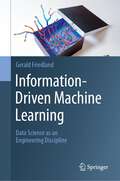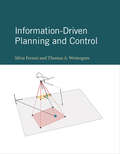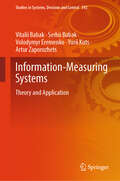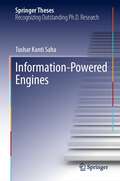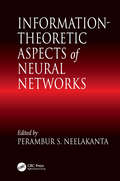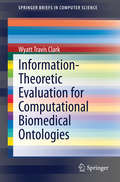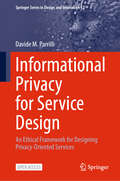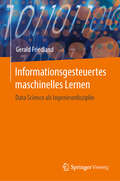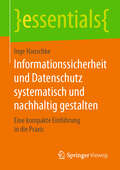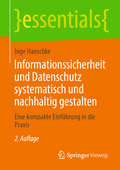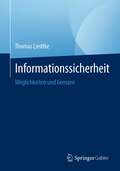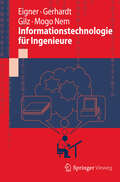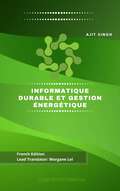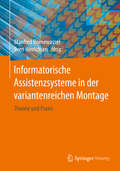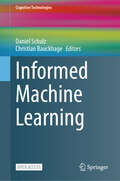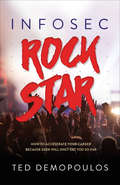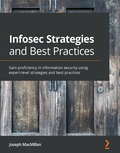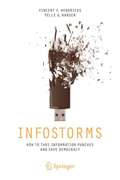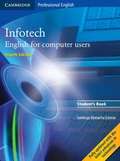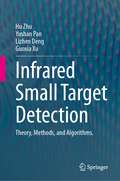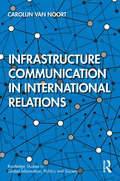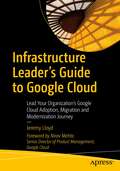- Table View
- List View
Information-Driven Machine Learning: Data Science as an Engineering Discipline
by Gerald FriedlandThis groundbreaking book transcends traditional machine learning approaches by introducing information measurement methodologies that revolutionize the field. Stemming from a UC Berkeley seminar on experimental design for machine learning tasks, these techniques aim to overcome the 'black box' approach of machine learning by reducing conjectures such as magic numbers (hyper-parameters) or model-type bias. Information-based machine learning enables data quality measurements, a priori task complexity estimations, and reproducible design of data science experiments. The benefits include significant size reduction, increased explainability, and enhanced resilience of models, all contributing to advancing the discipline's robustness and credibility. While bridging the gap between machine learning and disciplines such as physics, information theory, and computer engineering, this textbook maintains an accessible and comprehensive style, making complex topics digestible for a broad readership. Information-Driven Machine Learning explores the synergistic harmony among these disciplines to enhance our understanding of data science modeling. Instead of solely focusing on the "how," this text provides answers to the "why" questions that permeate the field, shedding light on the underlying principles of machine learning processes and their practical implications. By advocating for systematic methodologies grounded in fundamental principles, this book challenges industry practices that have often evolved from ideologic or profit-driven motivations. It addresses a range of topics, including deep learning, data drift, and MLOps, using fundamental principles such as entropy, capacity, and high dimensionality. Ideal for both academia and industry professionals, this textbook serves as a valuable tool for those seeking to deepen their understanding of data science as an engineering discipline. Its thought-provoking content stimulates intellectual curiosity and caters to readers who desire more than just code or ready-made formulas. The text invites readers to explore beyond conventional viewpoints, offering an alternative perspective that promotes a big-picture view for integrating theory with practice. Suitable for upper undergraduate or graduate-level courses, this book can also benefit practicing engineers and scientists in various disciplines by enhancing their understanding of modeling and improving data measurement effectively.
Information-Driven Planning and Control (Cyber Physical Systems Series)
by Silvia Ferrari Thomas A. WettergrenA unified framework for developing planning and control algorithms for active sensing, with examples of applications for specific sensor technologies.Active sensor systems, increasingly deployed in such applications as unmanned vehicles, mobile robots, and environmental monitoring, are characterized by a high degree of autonomy, reconfigurability, and redundancy. This book is the first to offer a unified framework for the development of planning and control algorithms for active sensing, with examples of applications for a range of specific sensor technologies. The methods presented can be characterized as information-driven because their goal is to optimize the value of information, rather than to optimize traditional guidance and navigation objectives.
Information-Measuring Systems: Theory and Application (Studies in Systems, Decision and Control #592)
by Artur Zaporozhets Volodymyr Eremenko Vitalii Babak Yurii Kuts Serhii BabakThis book concentrates on virtual IMS with the use of modern information and measurement modeling technologies. Modern IMS can be implemented as: real hardware and software measuring tools; virtual IMS with the use of modern information and measurement modeling technologies, including simulation, mathematical, physical, with extensive use of computer equipment for conducting a simulation measurement experiment. Compared to real ones, virtual IMS has a number of advantages, and their implementation requires less time, production, and financial costs. However, in a number of cases, due to the information uncertainty of the object of measurement, such IMS cannot provide objective and reliable results, and therefore, it is necessary to conduct a full-scale measurement experiment using real systems. The potential capabilities of modern systems at the stage of information development of society have increased significantly, which contributes both to the expansion of the subject areas of their application and their use to increase the efficiency of known and solve new scientific and applied measurement tasks. The authors are in solidarity with other colleagues—specialists in measurements—in the forecasts of the development of IMS. No improvements in measurement information technologies, including computer and intellectual ones, have not led, are not leading, and obviously cannot lead in future to the expansion of the nomenclature of measurements of quantities while there are no corresponding sensors that form primary information during their direct interaction with the research object. Further development of IMS and their use in various fields of science and technology, including quantum metrology and nanotechnology, will largely be determined by the development of new principles of operation and the creation of new types of sensors based on them.
Information-Powered Engines (Springer Theses)
by Tushar Kanti SahaThis book presents the experimental development of an information-powered engine inspired by the famous thought experiment, Maxwell’s demon, to understand its potential to produce energy for practical purposes. The development of an engine based on Maxwell’s demon was for a long time inconceivable, but technological advances have led to novel investigations into theoretical and practical applications. The built information engine consists of a micron-sized glass bead trapped in a tightly focused laser beam. It rectifies the bead's Brownian motion by controlling the laser's position and generates a unidirectional motion against gravity without doing any work, thus converting thermal heat into stored gravitational potential energy. A theoretical model based on a spring-mass system describes the engine's dynamics and was then used to find optimum parameters to improve the engine's performance. Experimentally implementing these optimization strategies led to engine output powers comparable to those measured in biological motors. This book also highlights performance improvements made in the presence of measurement noise and presents important guiding principles to design information engines to operate in non-equilibrium environments. By focusing on practical applications, the book overall aims to broaden the scope of information-engine investigations.
Information-Theoretic Aspects of Neural Networks
by P. S. NeelakantaInformation theoretics vis-a-vis neural networks generally embodies parametric entities and conceptual bases pertinent to memory considerations and information storage, information-theoretic based cost-functions, and neurocybernetics and self-organization. Existing studies only sparsely cover the entropy and/or cybernetic aspects of neural information.Information-Theoretic Aspects of Neural Networks cohesively explores this burgeoning discipline, covering topics such as:Shannon information and information dynamicsneural complexity as an information processing systemmemory and information storage in the interconnected neural webextremum (maximum and minimum) information entropyneural network trainingnon-conventional, statistical distance-measures for neural network optimizationssymmetric and asymmetric characteristics of information-theoretic error-metricsalgorithmic complexity based representation of neural information-theoretic parametersgenetic algorithms versus neural informationdynamics of neurocybernetics viewed in the information-theoretic planenonlinear, information-theoretic transfer function of the neural cellular unitsstatistical mechanics, neural networks, and information theorysemiotic framework of neural information processing and neural information flowfuzzy information and neural networksneural dynamics conceived through fuzzy information parametersneural information flow dynamicsinformatics of neural stochastic resonanceInformation-Theoretic Aspects of Neural Networks acts as an exceptional resource for engineers, scientists, and computer scientists working in the field of artificial neural networks as well as biologists applying the concepts of communication theory and protocols to the functioning of the brain. The information in this book explores new avenues in the field and creates a common platform for analyzing the neural complex as well as artificial neural networks.
Information-Theoretic Evaluation for Computational Biomedical Ontologies
by Wyatt Travis ClarkThe development of effective methods for the prediction of ontological annotations is an important goal in computational biology, yet evaluating their performance is difficult due to problems caused by the structure of biomedical ontologies and incomplete annotations of genes. This work proposes an information-theoretic framework to evaluate the performance of computational protein function prediction. A Bayesian network is used, structured according to the underlying ontology, to model the prior probability of a protein's function. The concepts of misinformation and remaining uncertainty are then defined, that can be seen as analogs of precision and recall. Finally, semantic distance is proposed as a single statistic for ranking classification models. The approach is evaluated by analyzing three protein function predictors of gene ontology terms. The work addresses several weaknesses of current metrics, and provides valuable insights into the performance of protein function prediction tools.
Informational Privacy for Service Design: An Ethical Framework for Designing Privacy-Oriented Services (Springer Series in Design and Innovation #52)
by Davide M. ParrilliThis open access book equips designers with a deeper understanding of informational privacy, emphasizing why and how designers should design services that respect and enhance people’s privacy. The solution to these issues is more important and challenging in our globalized service and design landscape. In their quest to understand the rationale for privacy in service design, authors embarked on an extensive journey through various disciplines and practices. Ultimately, author grounded their findings in ethics and philosophy from a designerly (thus pragmatic) and multicultural perspective. The next challenge has been to translate these ethical and philosophical principles into practical guidelines for designers: an easy to implement and global privacy ethical framework for service designers.
Informationsgesteuertes maschinelles Lernen: Data Science als Ingenieurdisziplin
by Gerald FriedlandDieses innovative Lehrbuch revolutioniert das maschinelle Lernen durch neue Informationsmessungsmethoden. Es basiert auf einem Seminar der UC Berkeley und zielt darauf ab, die Black-Box-Natur des maschinellen Lernens zu überwinden, indem es Datenqualitätsmessungen und A-priori-Schätzungen der Aufgabenkomplexität ermöglicht. Dies führt zu kleineren, erklärbareren und robusteren Modellen.Das Lehrbuch verbindet maschinelles Lernen mit Physik, Informationstheorie und Computertechnik und ist für ein breites Publikum verständlich. Es hinterfragt bestehende Branchenpraktiken und behandelt Themen wie Deep Learning und Datendrift. Geeignet für Akademiker und Industrieprofis, fördert es ein tiefgreifendes Verständnis von Data Science und lädt Leser ein, über konventionelle Ansätze hinauszudenken. Anstatt sich ausschließlich auf das „Wie“ zu konzentrieren, bietet dieser Text Antworten auf die „Warum“-Fragen, die das Fachgebiet durchdringen, und beleuchtet die zugrunde liegenden Prinzipien maschineller Lernprozesse und ihre praktischen Auswirkungen. Indem dieses Buch systematische Methoden bevorzugt, die auf physikalischen Grundprinzipien basieren, stellt es Branchenpraktiken in Frage, die oft aus ideologischen oder gewinnorientierten Motivationen entstanden sind. Es behandelt eine Reihe von Themen, darunter Deep Learning, Datendrift und MLOps, und nutzt ausgiebig grundlegende Konzepte wie Entropie, Kapazität und hohe Dimensionalität.Dieses Buch ist sowohl für Hochschul- als auch für Industrieprofis geeignet und dient als wertvolles Werkzeug für diejenigen, die ihr Verständnis von Data Science als Ingenieurdisziplin vertiefen möchten. Der zum Nachdenken anregende Inhalt regt die intellektuelle Neugier an und richtet sich an Leser, die mehr wollen als nur Code oder vorgefertigte Formeln. Der Text lädt die Leser dazu ein, über konventionelle Standpunkte hinauszuforschen und bietet eine alternative Perspektive, die eine umfassende Sichtweise für die Integration von Theorie und Praxis fördert. Dieses Buch eignet sich für Kurse im Grund- und Hauptstudium und kann auch praktizierenden Ingenieuren und Wissenschaftlern verschiedener Disziplinen zugute kommen, indem es ihr Verständnis der Modellierung vertieft und die Datenmessung effektiv verbessert.
Informationssicherheit und Datenschutz systematisch und nachhaltig gestalten: Eine kompakte Einführung in die Praxis (essentials)
by Inge HanschkeIn diesem Buch werden die Anforderungen der EU-Datenschutz-Grundverordnung (EU-DSGVO ) und des Informationssicherheitsmanagements eingeführt. Es wird aufgezeigt, welche wesentlichen Bestandteile für ein integriertes, einfaches und effektives Management-Instrumentarium erforderlich sind. Durch die Kombination mit Enterprise Architecture Management, IT-Servicemanagement und weiteren Disziplinen in ein integriertes Managementsystem kann die Wirksamkeit noch erhöht werden. Neben einer Einführung erhält der Leser Tipps und Tricks für die typischen Fallstricke in der Praxis sowie unmittelbar anwendbare Leitfäden und Empfehlungen – und dies kurz und prägnant.
Informationssicherheit und Datenschutz systematisch und nachhaltig gestalten: Eine kompakte Einführung in die Praxis (essentials)
by Inge HanschkeIn diesem Buch werden die Anforderungen der EU-Datenschutz-Grundverordnung (EU-DSGVO) und des Informationssicherheitsmanagements eingeführt. Es wird aufgezeigt, welche wesentlichen Bestandteile für ein integriertes, einfaches und effektives Management-Instrumentarium erforderlich sind. Durch die Kombination mit Enterprise Architecture Management, IT-Servicemanagement und weiteren Disziplinen in ein integriertes Managementsystem kann die Wirksamkeit noch erhöht werden. Neben einer Einführung erhält der Leser Tipps und Tricks für die typischen Fallstricke in der Praxis sowie unmittelbar anwendbare Leitfäden und Empfehlungen – und dies kurz und prägnant. In der 2. Auflage wurden kleinere Fehler korrigiert.
Informationssicherheit: Möglichkeiten und Grenzen
by Thomas LiedtkeDieses Buch erklärt die wichtigsten Fachbegriffe und Inhalte und ordnet diese den entsprechenden Bereichen zu. Einbezogen werden auch scheinbare Randgebiete, die für die Informationssicherheit ebenfalls eine Rolle spielen. So wird der Themenkomplex Safety und Privacy hinsichtlich seiner Gemeinsamkeiten und Unterschiede beleuchtet. Das Buch zeigt aktuell verwendete Angriffsmuster und wie man sich dagegen schützen kann. Schutz muss dabei sowohl auf technischer Ebene (z. B. durch den Einsatz von Kryptographie) als auch auf organisatorischer und personeller Ebene (z. B. durch entsprechende Managementsysteme und Awareness-Schulungen) erfolgen. Wie lässt sich feststellen, wie sicher Daten sind? Wie lassen sich relevante Bedrohungen finden, gegen die man sich schützen muss? Wie verlaufen Risikoanalysen?
Informationstechnologie für Ingenieure
by Torsten Gilz Martin Eigner Fabrice Mogo Nem Florian GerhardtTechnische Produkte sind heute komplexe Systeme, die von mehreren Ingenieurdisziplinen gemeinsam entwickelt werden. Deshalb gehört die Informationstechnologie zum Ausbildungscurriculum von Ingenieuren. In dem Buch werden technische Anwendungssysteme für die Entwicklung (Computer Aided Design), die Berechnung und Simulation (Computer Aided Engineering), die Administration (Product Lifecycle Management) und die Visualisierung vorgestellt. Auch der mechatronische Produktentwicklungsprozess und die Softwareerstellung werden detailliert erläutert.
Informatique Durable et Gestion Énergétique
by Ajit SinghL’informatique durable est l’effort de réduction de la consommation d’énergie des ordinateurs par l’efficacité. Elle suit l’idéal de développement durable : le progrès sans compromettre le futur. Même si les ordinateurs n’utilisent que 3% de l’énergie aux Etats-Unis, les solutions informatiques permettent d’avoir une plus grande influence sur l’informatique durable. Les termes informatique durable, informatique verte, numérique responsable et éco-TIC peuvent être utilisés de manière interchangeable. Lorsqu’ils sont activement mis en œuvre, ils répondent à la responsabilité éthique de protéger l’environnement en soutenant l’efficacité énergétique. Pour les sociétés, l’informatique durable fait partie du programme de responsabilité sociale des entreprises (RSE). Trois motivations de l’informatique durable sont le profit, les règlementations et l’éthique.
Informatorische Assistenzsysteme in der variantenreichen Montage: Theorie und Praxis
by Manfred Bornewasser Sven HinrichsenIn diesem Buch werden die Herausforderungen bei der Einführung von informatorischen Assistenzsystemen in der Montage erörtert und umfangreiche Gestaltungsempfehlungen vermittelt.Die industrielle Montage ist in Deutschland nach wie vor von hoher volkswirtschaftlicher Bedeutung. In der Industrie existieren zehntausende Montagearbeitsplätze. Diese verändern sich. Infolge hoher Wettbewerbsintensität und Innovationsdynamik entstehen immer mehr Produktvarianten, die zu einer Zunahme der Komplexität der Montagearbeit beitragen. Es stellt sich daher die Frage, wie mit dieser gestiegenen Komplexität umzugehen und wie diese seitens der Beschäftigten zu bewältigen ist, ohne dass es zu Überbeanspruchungen und einem Verfehlen von Produktivitätszielen kommt. Während Montage bislang vornehmlich als energetische Arbeit begriffen wurde, rücken künftig die kognitiven Anteile der Montagearbeit in den Vordergrund. In diesem Zusammenhang kommt dem Komplexitäts- und Informationsmanagement eine entscheidende Rolle zu: Während früher Strategien des Vereinfachens, z. B. durch fortschreitende Arbeitsteilung, im Vordergrund standen, gewinnen heute Strategien des Beherrschens der Komplexität an Bedeutung. Im Zentrum dieses Paradigmenwechsels stehen informatorische Assistenzsysteme, die den Beschäftigten im Montageprozess mit Informationsangeboten unterstützen und so die wachsende Komplexität sicher beherrschbar machen.
Informed Machine Learning (Cognitive Technologies)
by Daniel Schulz Christian BauckhageThis open access book presents the concept of Informed Machine Learning and demonstrates its practical use with a compelling collection of applications of this paradigm in industrial and business use cases. These range from health care over manufacturing and material science to more advanced combinations with deep learning, say, in the form of physical informed neural networks. The book is intended for those interested in modern informed machine learning for a wide range of practical applications where the aspect of small data sets is a challenge. Machine Learning with small amounts of data? After the recent success of Artificial Intelligence based on training with massive amounts of data, this idea may sound exotic. However, it addresses crucial needs of practitioners in industry. While many industrial applications stand to benefit from the use of AI, the amounts of data needed by current learning paradigms are often hard to come by in industrial settings. As an alternative, learning methods and models are called for which integrate other sources of knowledge in order to compensate for the lack of data. This is where the principle of “Informed Machine Learning” comes into play. Informed Machine Learning combines purely data driven learning and knowledge-based techniques to learn from both data and knowledge. This has several advantages. It reduces the need for data, it often results in smaller, less complex and more robust models, and even makes machine learning applicable in settings where data is scarce. The kind of knowledge to be incorporated into learning processes can take many different forms, for example, differential equations, analytical models, simulation results, logical rules, knowledge graphs, or human feedback which makes the approach overall very powerful and widely applicable.
Informed Urban Environments: Data-Integrated Design for Human and Ecology-Centred Perspectives (The Urban Book Series)
by Katia Perini Michael U. Hensel Ata ChokhachianThis book collects ground-breaking works on the actual and potential impact of big data and data-integrated design for resilient urban environments, including human- and ecology-centred perspectives. Comprehending and designing for urban social, demographic and environmental change is a complex task. Big data, data structuring, data analysis (i.e. AI and ML) and data-integrated design can play a significant role in advancing approaches to this task. The themes presented in this book include urban adaptation, urban morphology, urban mobility, urban ecosystems, urban climate, urban ecology and agriculture. Given the compound nature of complex sustainability problems, most chapters address the correlation between several of these themes. The book addresses practitioners, researchers and graduate students concerned with the rapidly increasing role of data in developing urban environments.
Informing Energy and Climate Policies Using Energy Systems Models
by George Giannakidis Maryse Labriet Brian Ó Gallachóir Giancarlo TosatoThis book highlights how energy-system models are used to underpin and support energy and climate mitigation policy decisions at national, multi-country and global levels. It brings together, for the first time in one volume, a range of methodological approaches and case studies of good modeling practice on a national and international scale from the IEA-ETSAP energy technology initiative. It provides insights for the reader into the rich and varied applications of energy-system models and the underlying methodologies and policy questions they can address. The book demonstrates how these models are used to answer complex policy questions, including those relating to energy security, climate change mitigation and the optimal allocation of energy resources. It will appeal to energy engineers and technology specialists looking for a rationale for innovation in the field of energy technologies and insights into their evolving costs and benefits. Energy economists will gain an understanding of the key future role of energy technologies and policy makers will learn how energy-system modeling teams can provide unique perspectives on national energy and environment challenges. The book is carefully structured into three parts which focus on i) policy decisions that have been underpinned by energy-system models, ii) specific aspects of supply and end-use sector modeling, including technology learning and behavior and iii) how additional insights can be gained from linking energy-system models with other models. The chapters elucidate key methodological features backed up with concrete applications. The book demonstrates the high degree of flexibility of the modeling tools used to represent extremely different energy systems, from national to global levels.
Infosec Rock Star: How to Accelerate Your Career Because Geek Will Only Get You So Far
by Ted DemopoulosHave you noticed that some people in infosec simply have more success than others, however they may define success? Some people are simply more listened too, more prominent, make more of a difference, have more flexibility with work, more freedom, choices of the best projects, and yes, make more money. They are not just lucky. They make their luck. The most successful are not necessarily the most technical, although technical or "geek" skills are essential. They are an absolute must, and we naturally build technical skills through experience. They are essential, but not for Rock Star level success. The most successful, the Infosec Rock Stars, have a slew of other equally valuable skills, ones most people never develop nor even understand. They include skills such as self direction, communication, business understanding, leadership, time management, project management, influence, negotiation, results orientation, and lots more . . . Infosec Rock Star will start you on your journey of mastering these skills and the journey of moving toward Rock Star status and all its benefits. Maybe you think you can’t be a Rock Star, but everyone can MOVE towards it and reap the benefits of vastly increased success. Remember, “Geek” will only get you so far . . .
Infosec Strategies and Best Practices: Gain proficiency in information security using expert-level strategies and best practices
by Joseph MacMillanAdvance your career as an information security professional by turning theory into robust solutions to secure your organizationKey FeaturesConvert the theory of your security certifications into actionable changes to secure your organizationDiscover how to structure policies and procedures in order to operationalize your organization's information security strategyLearn how to achieve security goals in your organization and reduce software riskBook DescriptionInformation security and risk management best practices enable professionals to plan, implement, measure, and test their organization's systems and ensure that they're adequately protected against threats. The book starts by helping you to understand the core principles of information security, why risk management is important, and how you can drive information security governance. You'll then explore methods for implementing security controls to achieve the organization's information security goals. As you make progress, you'll get to grips with design principles that can be utilized along with methods to assess and mitigate architectural vulnerabilities. The book will also help you to discover best practices for designing secure network architectures and controlling and managing third-party identity services. Finally, you will learn about designing and managing security testing processes, along with ways in which you can improve software security. By the end of this infosec book, you'll have learned how to make your organization less vulnerable to threats and reduce the likelihood and impact of exploitation. As a result, you will be able to make an impactful change in your organization toward a higher level of information security.What you will learnUnderstand and operationalize risk management concepts and important security operations activitiesDiscover how to identify, classify, and maintain information and assetsAssess and mitigate vulnerabilities in information systemsDetermine how security control testing will be undertakenIncorporate security into the SDLC (software development life cycle)Improve the security of developed software and mitigate the risks of using unsafe softwareWho this book is forIf you are looking to begin your career in an information security role, then this book is for you. Anyone who is studying to achieve industry-standard certification such as the CISSP or CISM, but looking for a way to convert concepts (and the seemingly endless number of acronyms) from theory into practice and start making a difference in your day-to-day work will find this book useful.
Infostorms
by Vincent F. Hendricks Pelle G. HansenThe information society is upon us and with it comes the constant barrage of information accessible wherever, whenever. This book explores the role of knowledge (or lack thereof) prevalent in society, and investigates the dangers lurking in information technology and democracy as a whole.<P><P> Information is a condition for a robust democracy; people should vote based on sound information. But sound information doesn’t come easy and without labor. It must be properly handled and formatted before it is useful for deliberation, decision and action. In the information age, understanding the means by which information is processed becomes a crucial democratic instrument for the individual as well as the group.<P><P> With points of departure in philosophy, social psychology, economics, and choice- and game theory, Infostorms shows how information may be used to improve the quality of personal decision and group thinking but also warns against the informational pitfalls which modern information technology may amplify. Covering topics including the continued war efforts, the social media success, polarization in politics, stock, science or opinion bubbles this book’s broad approach offers an excellent overview on information (technology) and valuable guidance on how to take information punches.
Infostorms: Why do we 'like'? Explaining individual behavior on the social net, 2nd Edition
by Vincent F. Hendricks Pelle G. HansenWith points of departure in philosophy, logic, social psychology, economics, and choice and game theory, Infostorms shows how information may be used to improve the quality of personal decision and group thinking but also warns against the informational pitfalls which modern information technology may amplify: From science to reality culture and what it really is, that makes you buy a book like this.<P><P> The information society is upon us. New technologies have given us back pocket libraries, online discussion forums, blogs, crowdbased opinion aggregators, social media and breaking news wherever, whenever. But are we more enlightened and rational because of it? <P> Infostorms provides the nuts and bolts of how irrational group behaviour may get amplified by social media and information technology. If we could be collectively dense before, now we can do it at light speed and with potentially global reach. That’s how things go viral, that is how cyberbullying, rude comments online, opinion bubbles, status bubbles, political polarisation and a host of other everyday unpleasantries start. Infostorms will give the story of the mechanics of these phenomena. This will help you to avoid them if you want or learn to start them if you must. It will allow you to stay sane in an insane world of information.
Infotech English for Computer Users
by Santiago Remacha EsterasFully updated in line with the latest developments in Information Communications Technology (ICT), this course teaches students the language and skills they need to understand and work in the world of computers. A focus on terminology is combined with vocabulary and grammar practice to give students the tools to use English in areas such as describing features and functions, applying for jobs and discussing the world of ICT. The Student's Book contains 30 topic-based units covering everything from computer essentials through to programming, web design, job-hunting, and future technologies.
Infrared Small Target Detection: Theory, Methods, and Algorithms.
by Hu Zhu Yushan Pan Lizhen Deng Guoxia XuUncover the secrets of cutting-edge research in “Infrared Small Target Detection,” a crucial resource that delves into the dynamic world of infrared imaging and detection algorithms. This comprehensive book is an indispensable gem for the research community, offering a profound introduction to the theory, methods, and algorithms underlying infrared small object detection. As an invaluable guide, this book explores diverse models and categories of infrared small object detection algorithms, providing meticulous descriptions and comparisons of their strengths and limitations. Perfectly tailored for researchers, practitioners, and students with a passion for infrared imaging and detection, this book equips readers with the necessary knowledge to embark on groundbreaking investigations in this field.Readers can particularly be drawn to the book's methods, results, and topics, encompassing diverse categories of infrared small object detection algorithms and their corresponding advantages and disadvantages. The book also imparts foundational knowledge in mathematical morphology, tensor decomposition, and deep learning, enabling readers to grasp the underlying principles of these advanced algorithms. Experience the key benefits of “Infrared Small Target Detection” as readers gain a profound understanding of theory, methods, and algorithms tailored to infrared small object detection. The comprehensive descriptions and comparisons of various algorithm categories empower readers to select the perfect algorithms for their specific applications. Unlock the potential of this groundbreaking resource with a basic understanding of mathematics, statistics, and image processing. Some familiarity with infrared imaging and detection proves advantageous in fully immersing oneself in the wealth of knowledge presented within these pages.
Infrastructure Communication in International Relations (Routledge Studies in Global Information, Politics and Society)
by Carolijn van NoortThis book demonstrates how infrastructure projects and the communications thereof are strategized by rising powers to envision progress, to enhance the actor’s international identity, and to substantiate and leverage the actor’s vision of international order. While the physical aspects of infrastructure are important, infrastructure communication in international relations demands more scholarly attention. Using a case-study approach, Carolijn van Noort examines how rising powers communicate about infrastructure internationally and discusses the significance of these communication practices. The four case studies include BRICS’s summit communications about infrastructure, Brazil’s infrastructure promises to Africa, China’s communication of the Belt and Road Initiative in East Africa, and Kazakhstan’s news media coverage of China’s Belt and Road Initiative. Van Noort highlights the fact that the link between infrastructure, identity, and order-making is arbitrary and thus contested in practice, with rising powers operationalizing infrastructure communication in international relations in varied ways. She argues that both communication organization and the visuality of strategic narratives on infrastructure influence the international communication of infrastructure vision and action plans, with different levels of success. Infrastructure Communication in International Relations is a welcome and timely book of interest to students and scholars in the fields of international relations, global communications, and the politics of infrastructure.
Infrastructure Leader’s Guide to Google Cloud: Lead Your Organization's Google Cloud Adoption, Migration and Modernization Journey
by Jeremy LloydMaking fast and accurate technology decisions is critical to staying relevant to your customers. And technology needs to add value back to your organization quicker than ever. Google Cloud offers IT leaders the answer to today’s technology challenges. However, to realize its benefits you must navigate your journey without hitting common pitfalls that lead to stalled and unsuccessful cloud adoption. This book distills the lessons learned from guiding and working with hundreds of organizations on their journey to the cloud. Its goal is to give aspiring and current IT leaders the knowledge required to be an infrastructure leader. That is the term author Jeremy Lloyd uses for the person who can lead your organization's Google Cloud adoption strategy. Of course, cloud adoption isn’t a solo endeavor. Jeremy covers the different generations of IT leaders, the team structure, and the skills required for a successful migration to Google Cloud. This book also covers why you should choose Google Cloud, how to build a business case for the cloud, and defining your adoption/migration/modernization strategies and cloud operating model. Finally, the book covers how to empower your developers to deploy cloud-native applications and how to support day two operations once you have moved to Google Cloud.What You Will LearnUse Google Cloud to add value to your organizationDefine and lead your Google Cloud adoption strategy Migrate and modernize your workloadsOperate workloads once in Google Cloud and avoid antipatternsUnderstand how the infrastructure team can be enablers for cloud-native development Who This Book Is ForCurrent infrastructure/IT/technology leaders who need guidance for their Google Cloud adoption, migration, and modernization journey; IT managers, IT team leads and IT professionals aspiring to be the next IT leaders who must learn to navigate more than just technical complexity.
